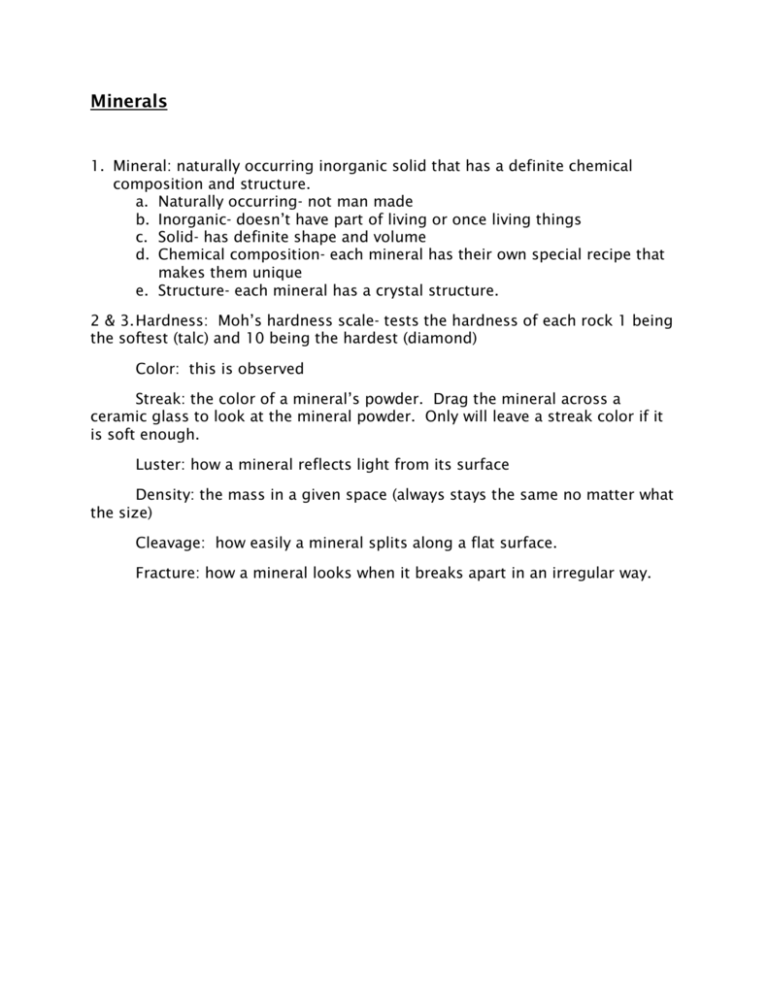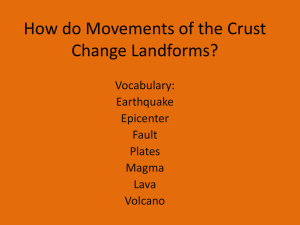Minerals - Fort Thomas Independent Schools
advertisement

Minerals 1. Mineral: naturally occurring inorganic solid that has a definite chemical composition and structure. a. Naturally occurring- not man made b. Inorganic- doesn’t have part of living or once living things c. Solid- has definite shape and volume d. Chemical composition- each mineral has their own special recipe that makes them unique e. Structure- each mineral has a crystal structure. 2 & 3. Hardness: Moh’s hardness scale- tests the hardness of each rock 1 being the softest (talc) and 10 being the hardest (diamond) Color: this is observed Streak: the color of a mineral’s powder. Drag the mineral across a ceramic glass to look at the mineral powder. Only will leave a streak color if it is soft enough. Luster: how a mineral reflects light from its surface Density: the mass in a given space (always stays the same no matter what the size) Cleavage: how easily a mineral splits along a flat surface. Fracture: how a mineral looks when it breaks apart in an irregular way. Rocks 1. Rock: the material that forms Earth’s hard surface. They are made up of minerals. 2. Igneous Rocks form from the cooling of molten rock- either magma below the surface or lava at the surface. Sedimentary rocks form when sediments are compacted and cemented together. Metamorphic rocks are formed when rocks, over a long period of time have had increased heat and pressure added to them and caused them to change. 3. Intrusive- formed when magma hardened beneath Earth’s surface – coarse or large grains. Extrusive_ formed from lava that erupted onto Earth’s surface- fine grained or glassy 4. Chemical- formed when a solution is evaporated Clastic- formed from fragments of other rocks Organic- formed from parts of once living animal (fossils, shells) 5. Foliated- banded minerals Non-foliated- mineral are distributed throughout the rock. 6. Cementation- minerals get dissolved by water, they act as a glue to keep the rock fragments together. Compaction- the pressure from the layers upon pushing on the rock below 7. The rock cycle is continuously changing from one type of rock to another. Layers of the Earth/Continental Drift 1. Crust: the layer of rock that forms Earth’s outer skin Mantle: layer of hot rock Lithosphere: part of crust and mantle together form a rigid layer. Asthenosphere: the soft layer of the mantle in which the lithosphere floats. Outer core: layer of molten metal that surrounds the inner core. Inner core: a dense ball of solid metal. 2. Continental Drift Theory – all the continents had once been joined together in a single landmass and have since drifted apart. By Wegener 3. Pangaea- the supercontinent. 4. Convection currents in the mantle cause the plates to move. The heating and cooling of the fluid, changes in the fluid’s density and the force of gravity combine to set convection currents in motion. 5. Lithosphere: part of crust and mantle together form a rigid layer. Asthenosphere: the soft layer of the mantle in which the lithosphere floats. 6. Subduction: when one plate sinks beneath another. It will be the plate that is denser than the other. 7. Divergent boundary; occurs where plates move apart. Most divergent boundaries are found in the ocean. As plates move apart, new crust is built, forming mid-ocean ridges and rift valleys. Convergent boundary: occurs where plates push together. Crust is destroyed where plates subduct. It is folded where plates collide. Continental-continental collision: where 2 plates carrying continental crust push together. Both crust are the same density, neither plate can sink beneath the other. This creates mountain ranges. Oceanic-oceanic subduction- where one plate with oceanic crust sinks or subducts under another plate with oceanic crust. The older plate is colder and denser than the younger plate so therefore it will subduct. Deep ocean trenches and island arc will form here. Oceanic-Continental Subduction- where ocean crust sinks under continental crust. The oceanic crust is colder and denser than continental crust. At these sites deep-ocean trenches form as well as coastal mountains. Transform boundary; occurs where the plates scrape past each other. Plates scrape horizontally past each other. Crust is neither formed nor destroyed. 8. Sea floor Spreading: forms rift valleys. This is where the plates move apart. Rising magma fills the cracks, and the rock cools. As more magma flows into the crack the rock splits, is pushed aside and produces ridges on either side of the rift valley.








